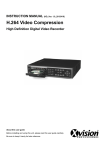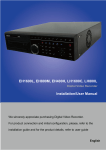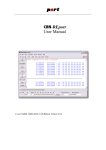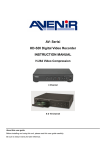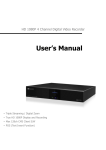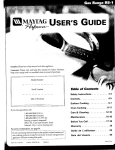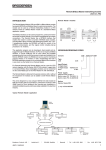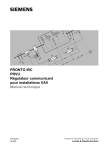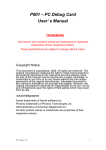Download User Manual - Knight Security Alarms, Inc
Transcript
1 | Chapter 1 : DVR User Manual H.264 HD-SDI 1080P Resolution Digital Video Recorder User’s Manual VER. 2.0 Future of Digital Video Recording at Hand User Manual | 2 Safety Information The safety information is provided for the wellness of the equipment and for the safety of the operator. Please review and observe all instructions and warnings in this manual. Note : Keep this manual handy every time you operate this equipment. Also, check with your dealer for further assistance and for the latest revision of this manual. Your dealer might provide you with a digital version of this manual. We also ask you to keep the original box and packing materials in case of return or for long-term storage of the DVR unit. Preparations before installation To protect your DVR from damage and to optimize performance, be sure to keep the DVR away from dust, humidity, and areas with high voltage equipment such as a refrigerator. Do not install or place equipment in areas where the air vents can be obstructed, such as in tight enclosures or small utility closets. Keeping the unit in a temperature-controlled room with ample regulated power is highly recommended. Do not overload the wall outlet, as this can result in the risk of fire or electric shock. Uninterruptible power devices such as UPS power surge protectors are recommended, and the DVR units must at least be connected with a UL, CUL, or CSA approved power surge protector. Avoid direct sun light and avoid heat. FCC Information This equipment has been tested and found to comply with the limits of Class A digital device, pursuant to part 15 of the FCC Rules. These limits are designed to provide reasonable protection against harmful interference when the equipment is operated in a commercial environment. This equipment generates, uses, and radiates radio frequency energy, and if not installed and used in accordance with the user manual, it may cause harmful interference to radio communications. Operation of this equipment in a residential area is likely to cause harmful interference, in which the user will be required to correct the interference at his own expense. Changes or modifications not expressly approved by the party responsible for compliance could void the user's authority to operate the equipment under FCC rules. UL Information - For pluggable equipment, the socket-outlet shall be installed near the equipment and shall be easily accessible. - If the battery is placed elsewhere in the equipment, there shall be a marking close to the battery or statement in the servicing instructions. CAUTION RISK OF EXPLOSION IF AN INCORRECT BATTERY TYPE IS USED. DISPOSE OF USED BATTERIES ACCORDING TO THE INSTRUCTIONS. THIS EQUIPMENT IS FOR INDOOR USE, AND ALL THE COMMUNICATION WIRING IS LIMITED TO INDOORS. 3 | H.264 HD Digital Video Recorder TABLE OF CONTENTS CHAPTER 1 : DVR USER MANUAL 1. GETTING STARTED .................................................................................................. 7 1.1 Checking Supplied Items ........................................................................................... 7 1.2 DVR Features ........................................................................................................... 8 1.3 System Startup and Shutdown .................................................................................. 9 1.1.1 System Startup .................................................................................................... 9 1.1.2 System Login ...................................................................................................... 9 1.4 Front Panel ............................................................................................................... 10 1.5 Rear Panel ................................................................................................................ 11 1.6 IR Remote Control ................................................................................................. 12 2. OPERATION ............................................................................................................... 13 2.1 Live Display Mode................................................................................................... 13 2.1.1 Channel Selection ............................................................................................ 13 2.1.2 Icons Description ............................................................................................. 14 2.1.3 Toolbar ............................................................................................................. 14 2.1.4 Pop-up Menu .................................................................................................... 15 2.2 FREEZE MODE .......................................................................................................... 15 2.3 Digital Zoom .......................................................................................................... 16 2.4 PTZ Operation ........................................................................................................ 16 2.4.1Initialize ............................................................................................................ 17 2.4.2 Pan/ Tilt ............................................................................................................ 17 2.4.3 Zoom/ Focus ..................................................................................................... 17 2.4.4OSD Menu ......................................................................................................... 17 2.4.5 Auto Scan ......................................................................................................... 17 2.4.6 Preset ............................................................................................................... 17 2.4.7 Tour .................................................................................................................. 18 2.4.8 PTZ Exit ........................................................................................................... 18 2.4.9 OSD Control Via Coaxial Cable ...................................................................... 18 2.5 Instant Playback of Recorded Video ...................................................................... 20 2.6 Backup & Instant Backup ....................................................................................... 21 2.6.1 Backup ............................................................................................................... 21 2.6.2 Instant Backup .................................................................................................. 22 2.6.3 Backup Video Player ......................................................................................... 22 2.7 Search Recording Image .......................................................................................... 23 2.7.1 Calendar Search .............................................................................................. 23 2.7.2 Date & Time Search ......................................................................................... 24 2.7.3 First Data........................................................................................................... 24 2.7.4 Last Data .......................................................................................................... 24 2.7.5 System Log ...................................................................................................... 25 User Manual | 4 2.7.6 Event Log ......................................................................................................... 26 3. SETTINGS ................................................................................................................. 27 3.1 System ...................................................................................................................... 28 3.1.1 System Info ....................................................................................................... 28 3.1.2 User .................................................................................................................. 30 3.1.3 Export/ Import ................................................................................................ 32 3.1.4 HDD ................................................................................................................. 33 3.1.5 Factory Default ................................................................................................ 34 3.2 DEVICE .................................................................................................................... 35 3.2.1 Camera ............................................................................................................. 35 3.2.2 Audio ................................................................................................................ 36 3.2.3 Sensor ............................................................................................................. 37 3.2.4 Alarm ................................................................................................................ 37 3.2.5 Controller ......................................................................................................... 38 3.2.6 PTZ ................................................................................................................... 39 3.3 Record ..................................................................................................................... 40 3.3.1 Record Setup .................................................................................................... 40 3.3.2 Schedule ........................................................................................................... 42 3.4 Network .................................................................................................................. 43 3.4.1Network ............................................................................................................. 43 3.4.2 DDNS ............................................................................................................... 45 3.4.3 Notifications ..................................................................................................... 46 3.4.4 Network Setup for Internal Use ....................................................................... 48 3.4.5 Network Setup for External Use ....................................................................... 48 3.5 Quick Setup ........................................................................................................... 49 CHAPTER 2 : WEB VIEWER 4. WEB VIEWER .......................................................................................................... 51 4.1 Web Live Viewer ..................................................................................................... 51 4.2 Web Playback .......................................................................................................... 53 4.3 Image Capture ........................................................................................................ 54 4.4 Web Backup ............................................................................................................. 55 4.5 Web Setup ................................................................................................................ 56 4.5.1 System ............................................................................................................... 56 4.5.2 User .................................................................................................................. 56 4.5.3 Device ............................................................................................................... 57 4.5.4 Record ................................................................................................................ 57 4.5.5 Network ............................................................................................................ 58 4.5.6 Upgrade ........................................................................................................... 58 4.5.7 Information ....................................................................................................... 58 5 | H.264 HD Digital Video Recorder CHAPTER 3 : CLIENT SOFTWARE USER MANUAL 5. SINGLE SITE CLIENT SOFTWARE MANUAL ................................................. 60 5.1 PC Requirements...................................................................................................... 60 5.2 Multi-Site Software .................................................................................................. 60 5.3 Install ...................................................................................................................... 61 5.4 Uninstall ................................................................................................................. 61 5.5 Basic Operation ........................................................................................................ 62 5.5.1 Network Connection ......................................................................................... 62 5.5.2 Screen Layout for Live Mode ........................................................................... 64 5.5.3 Screen Layout for Search Mode ..................................................................... 65 5.5.4 PTZ Control Panel ........................................................................................... 66 5.5.5 Calendar Panel ............................................................................................... 66 5.5.6 Search Panel .................................................................................................... 67 5.6 Setup......................................................................................................................... 68 5.6.1 General ............................................................................................................. 68 5.6.2 Site .................................................................................................................... 69 5.6.3 Event ................................................................................................................. 70 5.6.4 Event Search .................................................................................................... 70 5.6.5 Record .............................................................................................................. 71 5.6.6 Disk .................................................................................................................. 72 5.6.7 Display ............................................................................................................. 73 5.6.8 About ................................................................................................................ 73 CHAPTER 4 : MOBILE PHONE SURVEILLANCE APPLICATION 6. MOBILE PHONE SOFTWARE USER GUIDE .................................................... 75 6.1 iPhone Application Software .................................................................................. 75 6.1.1 Installation ...................................................................................................... 75 6.1.2 How to Connect and View ................................................................................ 77 6.1.3 How to Search and PTZ Control .................................................................... 79 6.2 Android Application Software ................................................................................. 80 6.2.1 Installation ...................................................................................................... 80 6.2.2 How to Connect and View .............................................................................. 82 6.2.3 How to PTZ Control and Capture .................................................................... 83 7. APPENDIX: SPECIFICATIONS ............................................................................ 84 User Manual | 6 Chapter 1 DVR USER MANUAL 7 | Chapter 1 : DVR User Manual 1. Getting Started 1.1 Checking Supplied Items Verify you have the following items supplied with your DVR. If any of these items are missing or damaged, notify your vendor immediately. Do not dispose of the packing utilities in case of moving or storage purposes. Items Photo Quantity Quick Start Guide 1 CD (Manual & Software) 1 Power Cable and Rack Mount Bracket 1 (W/ Screws) IR Remote Controller 1 USB Mouse 1 Rack Mount Bracket (W/ Screws) 2 (Brackets) 4 (Screws) User Manual | 8 1.2 DVR Features H.264 Video Compression Recording & Playback at 1280x720 or 1920 x 1080 Full HD Display - HDMI Output (1920 x 1080) Digital Zoom Function on LIVE & PLAYBACK Multi-Channel Audio Recording Video Loss and S.M.A.R.T HDD Error Detection E-Mail Notification DVD-RW Built In Free DDNS Easy Software Upgrade by USB Port and Network Software Instant and Convenient Backup via USB Flash Drive, Network, or DVD-RW Watermarked Backup Format and Digital Zoom Function on DVR player AVI Backup Individual Channel Operation Intuitive and Easy GUI Interface Remote Client Software 4 Sensor Input, 2 Output Powerful Mobile Application on iPhone and Android Phone Easy and Convenient Setup 9 | Chapter 1 : DVR User Manual 1.3 System Startup and Shutdown 1.1.1 System Startup Make sure all necessary devices are properly connected to the back of the DVR (See section 1.5 REAR PANEL for additional information). Connect the power cord to the power jack on the rear panel of the DVR. The boot-up screen will display as shown below. Please wait until the boot-up process completes. When the DVR boots up for the first time, you will be asked to setup the language and date & time for the DVR. Then, live mode will display. TROUBLESHOOT Camera Connection Cameras must be connected to the system before turning on the DVR. If a camera is connected to the DVR is in use, the camera’s signal will not be detected properly. This may result in an abnormal display on live mode & an error message in playback mode. If this occurs, check the camera’s resolution & adjust the resolution settings in the DVR for that camera. Then, restart the system. 1.1.2 System Login LOGIN screen is displayed. Select USER (ADMIN/USER1/USER2/USER3), then enter the password. Default Password: 1111 User Manual | 10 1.4 Front Panel Front panel allows the user to operate the DVR without having to use the IR remote or a mouse. NOTE No. I- Backup (Instant Backup) In playback mode, the user can press the [I-BACKUP] button on the front keypad to configure both Start and End time. Once the times are set, click the [START] button to start the backup process. Buttons 1 Menu 2 Mode 3 Sequence 4 5 6 PTZ IR Receiver Instant Backup 7 Instant Playback 8 9 Search Panic Record 10 USB Port 11 12 13 14 15 16 Power DVD Door Button ESC Directional Arrows Enter Button Jog Shuttle LED Indicator Indicate Playback Navigator Channel Button 17 18 19 Functions Display the Setup Menu. Change the cameras display Mode between single channel & 4-channel view. Change the display channel automatically when in single channel mode. Control a PTZ camera. IR Receiver for Remote controller. Start “Instant Backup" to a USB flash drive. View video playback. By default, video will be displayed from the last 3 minutes before current time. Go to search mode. Start Emergency Recording. USB Port (Ver. 2.0) for Mouse Operation, Backup or Firmware Upgrade. Turn DVR On/Off. Open & Close the DVD’s protecting door. Exit Menu or back to previous menu. Menu Setup Navigation / Change Display Mode / PTZ Control. Select Value or Setting. Fast Forward or Rewind when playback. System Status (from top to bottom): Power, HDD, Record, Network and Backup. Play, Fast Forward, Rewind or pause. Select Display channel 1,2,3 and 4. 11 | Chapter 1 : DVR User Manual 1.5 Rear Panel No. Buttons 1 2 Video In HDMI Out 3 VGA 4 5 6 Audio In Audio Out Ethernet 7 USB 8 E-STATE 9 Input & Output 10 Power 11 RS-232C Functions Video input terminal 1920X1080 Main Monitor VGA (Video Graphics Array) output terminal. Connects to the PC VGA monitor. Four connectors for audio input. One connector for audio output. RJ45 Network terminal USB Terminal for mouse connection, backup and firmware upgrade. External SATA terminal 1 RS-485 For PTZ Camera 2 RS-485 For Keyboard Controller 3 Reserved Pin Currently not in use 4 Sensor Input Connect 4 sensors input 5 Alarm Output Connect 1 alarm output DC12V input RS-232 Connection terminal for engineering and debugging. User Manual | 12 1.6 IR Remote Control The IR remote controller allows you to control the DVR without the mouse or front panel buttons. To use IR Remote Controller, the ID of the IR Controller must be the same as the ID of the DVR. Default ID # for DVR and IR Remote Controller is “1”. If you have more than one DVR you can use one IR remote by setting a unique ID for each DVR. No. Buttons A B Power Display C F/REW D F/ADV E F Play REW G FF H I J Backup Alarm Setup K Audio L SEQ M N O Lock Record Search P Arrows Q Select R ID S ESC T U Number pads PTZ Functions Goes to standby mode or turns on Display single or split screen During playback - Moved video 60 seconds backward. During pause- Moved video one frame backward. During playback – Moves video 60 seconds forward. During pause – Moves video one frame forward. Play or pause the footage in playback Rewind video at different speeds during playback. Fast forward video at different speeds during playback. Start backup in live or playback mode. Disable alarm operation. Launch SETUP menu. Mute, Single, MIX for all channels in single or split mode. Start auto sequencing of the screen in full screen mode. Lock all of key function. Start and stop PANIC recording. Go to the search menu. Move Up/ Down/ Left/ Right between display menus. Select menu or store setup value. When using the controller with more than one DVR, press ID and the number corresponding to the DVR’s ID. During setting - return to previous menu screen. During playback - exit from playback. select channel (1~9) or enter DVR ID number Call a PTZ menu 13 | Chapter 1 : DVR User Manual 2. Operation 2.1 Live Display Mode 2.1.1 Channel Selection The images can be seen on real-time by in single channel or 4-channel mode as seen below. To switch from a single-channel view to a multi-channel view and vice versa, choose one of the following options: [1 Channel] [4 Channel] 1. Using your Remote Control (See section 1.6 IR Remote Control for more information): a. Press the channel number you wish to view in single-channel mode. b. Press the “Select” button to return to multi-channel mode. c. If “Select” is pressed while in multi-channel mode, the DVR will display the last channel seen in single mode. 2. Using the USB Mouse: a. Move the mouse’s cursor over to the channel you wish to view in single mode. b. Double-click on the screen. The channel selected will be displayed in single-channel mode. You can also right-click to open the pop-up menu (see section 2.1.5 Pop-up Menu) and select Display 1Screen. c. To change from single to multi-channel mode, right-click on the screen and select Display 4Screens. 3. Using the DVR’s Front Panel (See section 1.4 Front Panel for more information): a. Press the channel number you wish to view in single-channel mode from the four buttons at the top of the DVR’s front panel. b. Press the “Enter” button to return to multi-channel mode. c. If “Enter” is pressed while in multi-channel mode, the DVR will display the last channel seen in single mode. Administrator user can set different level of authorization for each user. If a certain user is not allowed to view a certain playback channel, then no image will appear on the display screen. Refer to 3.1.2 User for more information. User Manual | 14 2.1.2 Icons Description The DVR can be set to different recording modes, identified by an icon on each channel screen. Icon Shown on Upper Right Corner Icon Shown on Lower Right Side Continuous Record Using Emergency Recording Motion Detection Record PTZ control is activated Sensor input Record Channels are displayed in Sequence Mode Emergency Recording 2.1.3 Toolbar Move the mouse cursor to the bottom of the screen in live mode to view the menu bar. <Toolbar in Live mode> Setup Menu Single Screen Mode- Display the last channel viewed in single mode. Multi-Channel mode- Displays all 4 channels, based on user permissions. Freeze Button- Freeze live video Sequence Display Button Channel Selection Button Panic Record Button - In emergency recording, the system will follow recording settings. PTZ Control Button - Use the virtual PTZ controller to adjust the Pan/Tilt/Zoom/OSD/Tour/Auto-scan/Preset of a PTZ camera. Instant Playback - Playback the most recent video clip recorded HDD usage. If it shows 98%, 98% of the HDD space has been used for recording 15 | Chapter 1 : DVR User Manual NOTE If you do not see any icon on the top right corner of the live screen mode; it means that the system is not recording. In this case, you need to check the [RECORD] settings in the main setup menu. See section 3.3 RECORD for more information. 2.1.4 Pop-up Menu Right clicking with your mouse on the screen will open the pop-up menu. This menu includes the main features for easy access. DISPLAY Select from Single Channel mode or multi-channel mode. SEQUENCE The display screen will display all channels one after another in a sequence (Available on single-screen mode). Hear the audio from the camera through a speaker connected to DVR. Audio Mute, 1 channel or 4 channels. Enable or Disable “Alarm Out” function. AUDIO ALARM FREEZE PTZ PANIC RECORD INSTANT PLAYBACK SEARCH BACKUP MENU SYSTEM SHUTDOWN Live video pause in a still image (Refer to 2.2 Freeze). Enable PTZ control. Available only in single channel mode and only when camera is setup as PTZ. (Refer to 2.4 PTZ). Trigger Emergency Recording (Refer to 2.1.3 Toolbar). Play the latest video recorded (Refer to 2.5 Instant Playback). Go to Search mode. (Refer to 2.7 Search). Save recorded video to an external USB flash drive. (Refer to 2.6 Backup & Instant Backup). Go to the main menu to set up the DVR. (Refer to 3.0 Setting). Turn off the DVR. In order to turn it off, the password must be entered. 2.2 Freeze Mode Freeze mode turns live video display to a still image. The date/ time information does not, the system clock continues running. To turn freeze mode on, click the right button on the mouse when viewing a live image and select the [FREEZE] option on the pop-up menu. You can also click on the button at the menu bar. To resume the live view, press [FREEZE] again, or click the right button on the mouse and select the [FREEZE] option. User Manual | 16 2.3 Digital Zoom VMAX HD supports Digital Zoom feature during live and playback mode 1. Double click the target channel. 2. Click the left button of the mouse and drag to make rectangular shape. 3. The smaller the rectangle you draw, the bigger the zoom. 4. To go back to full-size screen, click anywhere on the screen. 2.4 PTZ Operation User can go to PTZ mode by selecting the button on the menu bar located on the bottom of the main screen (Feature available in single channel mode). You can also access the PTZ control from the DVR’s front panel PTZ button. In PTZ mode, click the right button on the mouse to display the pop-up menu for the PTZ function as seen in the image below. To indicate you are in PTZ mode, the PTZ icon will appear at the bottom of the screen. If you wish to switch from one PTZ channel to a new one, select INITIALIZE on the new channel to adjust the PTZ control to the settings set for the current channel. To setup your PTZ camera, please see section 3.2 Device for more information. NOTE If a PTZ camera is not connected or not setup properly in the setup menu, this feature will be disabled. 17 | Chapter 1 : DVR User Manual 2.4.1 INITIALIZE If you have multiple PTZ cameras connected to your VMAX HD, use the INITIALIZE command when you switch from one PTZ channel to the next. This will indicate to the DVR that the channel has been changed and the DVR will automatically update itself to match the PTZ settings of the current channel. 2.4.2 Pan/ Tilt If selected, this virtual controller will allow full control of the camera’s pan and tilt. Use this to adjust the camera’s view from the DVR. 2.4.3 Zoom/ Focus If selected, this virtual controller will allow full control of the camera’s zoom and focus. Use this to adjust the camera’s focus and optically zoom in and out of the camera’s view. 2.4.4 OSD Menu If selected, this virtual controller will allow full control of the camera’s On Screen Display (OSD). Use this to control the camera’s complete setup and configuration remotely from the DVR. 2.4.5 Auto Scan Auto Scan enables you to start and stop scan patterns set in the camera. When selected, a numeric pad will appear on the screen. Use it to select the auto scan you want to activate and select START. To stop an Auto Scan, click on the STOP button. NOTE Auto Scan setup and configuration must be done via the PTZ camera’s setup menu. Please consult your camera’s manual for more information. 2.4.6 Preset The Preset option enables you to setup and go to a specific preset. A preset is any unique position, focus and zoom set by the user for a specific purpose. When selected, a numeric pad will appear on the screen. Use it to select the preset number you want to modify or view. To set a specific preset, enter the preset’s number. Then, move the PTZ camera to the desired position and click on SET. To view a preset, enter the preset’s number and select GO. Make sure the preset you select has been set before selecting it. NOTE The number of presets varies for each PTZ camera based on make and model. The VMAX HD supports a maximum of 255 presets. Please consult your PTZ camera’s manual for more information. User Manual | 18 2.4.7 Tour The Tour option enables you to start and stop a specific tour. A Tour is a function that enables the PTZ camera to move between 2 predetermined presets. To start a Tour, use the numeric pad to select a specific tour. Then click START to get the camera to start following the tour. To stop the camera’s movement, click STOP. Tour setup requires at least two (2) presets to be available. NOTE Tour setup and configuration must be done via the PTZ camera’s setup menu. Please consult your camera’s manual for more information. 2.4.8 PTZ Exit To exit PTZ control in the DVR, click on PTZ Exit. 2.4.9 OSD Control Via Coaxial Cable The VMAX HD is equipped with the option of controlling the OSD menu of Digital Watchdog’s HD-SDI Cameras with no need for additional cabling. This feature makes installation and camera configuration simpler than ever before. Using the Coaxial cable as a two-way data transfer cable, the DVR can receive image from the camera and send back control commands at the same time. 1. To setup the DVR for OSD Remote Control (See Section 3.2.6 PTZ for more information): a. Go to the DVR’s Menu by following one of the following options: i. Right-click anywhere on the screen and select “Menu”. ii. Press the Menu button on the front panel of the DVR. iii. Press the Setup button in the IR Remote Control. b. In the DVR’s menu, go to Device PTZ. c. Select the channel you wish to setup. The screen behind the menu will display live image from the channel you have selected. d. Select “FASTRAX II COAX” from the Camera Protocol Drop-Down menu. e. Leave speed as default. f. Set the ID in the DVR’s setup menu to match the camera’s ID. The camera’s ID can be found in the camera’s OSD menu, under “Property”. REMEMBER! If you have more than one of Digital Watchdog’s HD-SDI cameras you wish to setup, you will have to assign each camera a different ID number. Then, match that ID number with the ID section in the DVR’s Setup menu (Device PTZ). 2. To Activate OSD Remote Control: a. In Live mode, select a single camera and switch to single-channel mode by following one of the following options: i. Double-click on the view from the selected channel 19 | Chapter 1 : DVR User Manual ii. Press the channel number in the top right corner of the DVR’s Front Panel/ iii. Press the channel number using the remote control’s numeric pad. b. Right-click anywhere on the screen and select “PTZ”. The PTZ icon will appear at the bottom right of the screen. NOTE If the camera has not been properly setup in the DVR’s Setup menu, the PTZ option will not be displayed in the Pop-Up Menu. c. Right- Click on the screen again and select OSD. d. The camera’s OSD menu will appear on the left side of the screen. e. The DVR’s OSD Virtual controller will appear on the bottom right side of the screen. f. Using the virtual controller’s arrows, move up and down the camera’s menu options. Move left and right to adjust any available variables in the camera’s setup menu. g. Click on “SEL” to select a category or enter a sub-menu. h. Click on “ESC” to exit a sub-menu into the camera’s main menu. 3. To Exit the Camera’s OSD Menu: a. Using the virtual controller, go to the camera’s 9. EXIT option and click “SEL”. b. Select “YES Save” to save any changes made to the camera’s configuration. c. Select “NO Save” to cancel any changes and exit the camera’s menu. User Manual | 20 2.5 Instant Playback of Recorded Video To go to Playback mode, select one of the following options: Click the button in the virtual menu bar or, right click on the screen and select “INSTANT PLAYBACK” from the pop-up menu. [Playback Screen & Tool Bar] Go to Channel Screen Display Search Bar In single channel mode, select a specific channel to view. Select from single and multi-channel view. The search bar will display by default 24 hours of recorded data from 3 minutes before current time. Times when there is data recorded will be marked in orange. Using the mouse, you can click on any portion of the search bar to view video from that time automatically Rewind. Select from 1x, 2x, 4x, 8x, 16x, 32x speed Frame-by-Frame Rewind Playback Controllers Pause video Play Video Frame-by-Frame Fast Forward Search Options Calendar Search Fast Forward. Select from 2x, 4x, 8x, 16x, 32x speed Select from Calendar Search, Date & Time Search, First or Last Data System Log Search or Event Log Search (See section 2.7 Search Recording Image for more information). Use this to search video for a specific date and time. (Dates available may vary depending on HDD size and settings. Please see 3.1.4 HDD for more information) Remote Backup Remote Backup video to an external storage device (See section 2.6.1 Backup for more information). Instant Backup Perform Quick Backup during Playback(See section 2.6.2 Instant Backup for more information). Close Button Close the playback mode and return to Live video. 21 | Chapter 1 : DVR User Manual 2.6 Backup & Instant Backup Connect an appropriate USB flash drive or insert an empty DVD to the DVD-RW and press start the instant playback, or to start the remote backup. 2.6.1 Backup You can backup video from your DVR to an external storage device. 1. Click button on the toolbar. The following screen will be shown. 2. Select what cameras you want to backup. 3. Set the beginning date & time in [FROM]. 4. Set the ending date & time in [TO]. 5. Select the external memory device the backup file will be save to. 6. Click [FORM] and select the format of the file: a. Screen: capture the live screen in a still image. b. Video (NSF): Backup duration is up to 24 hours and it is watermarked. c. Video (AVI): Backup duration is up to 1 hour. 7. Click [BACKUP] to start the backup process 8. The progress of the backup will be displayed in the progress bar. NOTE DVD option for backup device is only displayed when DVD writer is built-in to the DVR. to User Manual | 22 2.6.2 Instant Backup Click button on the toolbar. The system will be in instant backup mode. Click on the backup icon again to indicate the end time of the instant backup file. The INSTANT BACKUP screen will pop-up. Select format: NSF (Watermarked File Format) or AVI. Then, click NEXT and select the channels to back up. Press the START button to begin backing up the file. 2.6.3 Backup Video Player [NSF] When backing up video in NSF format, VMAX HD player will be saved with the video file. User can find it in the [DvrPlayer] folder in the USB flash drive. This function allows the user to play the video clip without having to install additional software on the computer. To view a backup viedo in the NSF player: 1. Open the DVDPlayer 2. Open the folder where the playback video is located. 3. Using your computer mouse, click and hold on the file you want to view and drag it to the display screen of the DVDPlayer. In 1channel full screen mode, Digital Zoom In/Out function is activated. Control the zoom in/out by scrolling the mouse’s wheel forward/backwards, respectively. < HD Player for NSF > [AVI] When archiving the video clip in AVI, it can be played with any general multimedia player. 23 | Chapter 1 : DVR User Manual 2.7 Search Recording Image There are four (4) ways to access the search features on the VMAX HD 1. Right click on the screen and select SEARCH in the pop-up menu. 2. Press the SEARCH button on the front panel. 3. Press the SEARCH button on the IR Remote Controller. 4. If in Playback mode, click on the Search options button in the menu bar. 2.7.1 Calendar Search The calendar displays dates with recorded video data in gray. Select the month and year by clicking the right and left arrow buttons. Then select the desired dates. The selected date is highlighted in orange. The recorded data for the selected date will appear. Once the recorded video data of the selected date appears, user can adjust the vertical search line to the time you want to view by clicking with the mouse on a specific part of the search line. User can select specific minutes by using the clock button above the search line. Click [OK] to play the selected video. The colors of the time bar are different, depending on the recording data: No Color-No Recording. Orange Color - Video recorded available Green Color- Video recorded with Audio available NOTE If you know the exact Date & Time you wish to playback, it’s recommended to use the “Date & Time” Search tool. If you are not sure about the specific date & time you are searching for, it is recommended to use the “Calendar” Search tool. User Manual | 24 2.7.2 Date/Time Search The calendar displays dates with recorded video data in gray color. The month and year by clicking on the arrows in the top right side of the window. Then select the desired dates. The selected date will be highlighted with orange color. Enter the desired time and click OK button to start the play. By default, the hours in the time bar will be displayed every three hours. 2.7.3 First Data This search option will display playback video of the oldest available recording. 2.7.4 Last Data This search option will display playback video of the latest available recording. 25 | Chapter 1 : DVR User Manual 2.7.5 System Log The System Log Search finds particular system log information, quickly and easily. The System Log Report can be save to a USB memory device as a .txt file. 1. Select a Date. 2. Select type of data you want to include in the log report. a. System: includes system reboot, errors and user access to the DVR. b. Setup: includes any setup changes. c. Panic Recording: when panic recording was enabled. d. Video: video loss. e. All: include all data. 3. Click Search to apply your selections to the log report. 4. To export the system log report to a USB drive, select the memory device from the list, and click EXPORT. 5. Once export is completed, the user can find a folder titled with the exported date created in the USB thumb drive (There is [system.log] file stored in the folder.) User Manual | 26 2.7.6 Event Log The Event Log Search finds particular events, quickly and easily. 1. Select a Date. 2. Select type of data you want to include in the log report. a. Motion: Video recorded when motion was detected. b. Sensor: Video recorded when a sensor was activated. c. Continuous: Video recorded continuously. d. Instant Recording: Video recorded when instant (panic) recording was enabled. e. All: include all data. 3. Click Search to apply your selections to the log report. 4. To export the system log report to a USB drive, select the memory device from the list, and click EXPORT. 5. Once export is completed, the user can find a folder titled with the exported date created in the USB thumb drive (There is [system.log] file stored in the folder). NOTE If there is no alarm log even after the alarm input setting has been made, please check the alarm connection port of the DVR rear panel. Some Event and/or System Log data will be displayed in more than one page. To view the next page of data, click the arrow buttons in the top right corner of the window. 27 | Chapter 1 : DVR User Manual 3. Settings General setting structure consists of System, Device, Record, Network, and Quick Setup as shown below. There are several ways to access the DVR’s setup menu: 1. Right click on the screen and select MENU. 2. Click on the menu button in the virtual menu bar. 3. Press setup in the IR remote controller. 4. Press the menu button in the DVR’s front panel. Each Setup menu includes a [HELP] button for instant help on main features and settings. If you need more information or clarification, click on the Help button for more information. [MENU] TIP If you remain in the menu screen without operation for 5minutes, the DVR automatically returns to live display mode. Main Menu SYSTEM DEVICE RECORD NETWORK QUICK SETUP Sub Menu SYSTEM INFO USER EXPORT/IMPORT HDD DEFAULT CAMERA AUDIO SENSOR ALARM CONTROLLER PTZ RECORD SETUP SCHEDULE NETWORK DDNS NOTIFICATIONS QUICK SETUP User Manual | 28 3.1 System The SYSTEM Setup menu allows you to view the DVR’s general information, modify user access to the DVR, export and import settings, manage the DVR’s HDDs or set the DVR to its factory default settings. 3.1.1 System Info 1. SITE NAME Set DVR ID using the mouse or the control button on the remote control. Press OK to apply the DVR ID. 2. DATE/TIME Set DVR date & time using the mouse or the control button on the remote control. Press OK to apply changes. 29 | Chapter 1 : DVR User Manual Select DAYLIGHT SAVING and select the appropriate daylight saving time zone. The options are: - OFF: Daylight saving is turned off. - USA: Applies the USA daylight saving time. - EU: Applies the EU daylight saving time. - OTHERS: If the time zone is neither USA nor EU, set the date and time of the daylight saving period. CAUTION If using OTHER daylight savings, do not set the start time to 23:00 for DLS. DLS cannot be applied if the date of BEGIN and END is the same. 3. LANGUAGE Select the display language. 4. REMOTE ID Select an ID of remote control. - Select ID number. - Press the same number as ID set in DVR on the remote. 5. VIDEO SIGNAL Shows the video resolution of each camera connected to DVR. 6. IP ADDRESS Shows the current network address of DVR. 7. MAC ADDRESS Shows the DVR’s unique Mac address. 8. KEY TONE Enable or Disable the key tone for button operation on the front or IR remote controller. 9. VIDEO OUTPUT(HDMI/VGA) Select the Video output resolution from the following options: - 1280x720p/1920x1080i/1920x1080p/1280x720p(DVI)/1920x1080i(DVI)/1920x108 0(DVI) - DVI (Digital Visual Interface) is for monitors that use DVI signal format. 10. F/W VERSION Shows the current firmware version installed on the DVR. 11. SYSTEM UPGRADE Users can easily upgrade the DVR via USB or Network (Remote Upgrade). a. Create a new folder named “upgrade” in the USB flash drive root directory. b. Copy the firmware upgrade files to that folder. User Manual | 30 c. Plug in the USB flash drive on the front panel. d. Select SYSTEM UPGRADE. e. Select ‘SCAN.’ The DVR will automatically begin the upgrade process. The progress of the upgrade will be displayed in the percentage bar. f. When Upgrade is complete, system will reboot to apply the new upgrade. 3.1.2 User 1 2 3 The user setup menu allows administrator to control different users’ access to the DVR. 1. PERMISSIONS Admin’s permissions will appear in gray, indicating it cannot be modified. Only the Admin will have access to the menu. a. PASSWORD CHECK: Check the boxes next to each user to enable or disable their access to specific features and to specific channels. 31 | Chapter 1 : DVR User Manual Selected Checkbox: The DVR will ask for a password when the function is selected for all users. b. Blank Checkbox: The DVR will not ask for a password when the function is selected for all users. c. SETUP: Enable/Disable of access to Setup d. PLAYBACK: Enable/Disable of access to Playback e. PTZ: Enable/Disable of access to PTZ Control f. NETWORK: Enable/Disable of access to Network 2. SELECT CHANNELS FOR PLAYBACK PERMISSIONS Admin’s Channel Access will be in gray, indicating it cannot be modified. a. Set authority level of playback on each user. b. Checked box: authorized to playback. c. Blank check box: No authority. 3. USER PASSWORD Options are ADMIN, USER1, USER2 and USER3. a. Select USER PASSWORD using the mouse or the control button on the remote control and press SEL button. b. Select the user you want to modify and enter the current password. c. Enter a new password and confirm password d. Select OK. Then the message “MATCH PASSWORD” will be displayed. i. The factory default password for all users is “1111”. ii. The password input is available up to 8 digits. NOTE Each DVR can have up to 4 users, including the Administrator. It is highly recommended to assign a new password to protect the system. User Manual | 32 3.1.3 Export/Import Users can copy and paste the system configuration values in this menu. 1. EXPORT SETUP TO USB enables user to copy the settings for the DVR to any USB memory devices. a. Click Export. b. A warning window will appear. If you wish to continue, click OK. c. The DVR will scan for the USB. d. If a proper USB is connected to the DVR, a ‘Configuration Success’ message will appear. 2. IMPORT SETUP FROM USB enables user to recall the settings saved from other systems using CD/DVD/USB memory devices. During the import process, make sure that the firmware version of source DVR is the same as the destination DVR. a. Click Import. b. A warning window will appear. If you wish to continue, click OK. c. The DVR will ask if you would like to save the imported settings. If yes, click OK. d. When the import process is complete, the DVR will request to remove the USB before rebooting. e. System will reboot to apply the imported settings. 33 | Chapter 1 : DVR User Manual 3.1.4 HDD [HDD] tab displays the information of HDD that is mounted on the VMAXHD. 1. [FORMAT] Formats the entire HDD installed in the DVR. 2. [HEALTH INFO] Displays the information of HDD. 3. [HDD INFO] Displays the information of HDD status. 2 1 3 4 5 6 7 8 9 4. OVERWRITE When enabled, the DVR will continue recording and overwrite the oldest existing recorded data once the hard drive is full. When disabled, the recording will stop once the hard drive is full. 5. RECORDING LIMIT Enable/disable recording limit. 6. LIMIT DAYS Set the recording limit days (1- 90days). If the RECORDING LIMIT DAYS are set to 1, data recorded will be overwritten after 24 hours. 7. TEMPERATURE LIMIT Set the specific temperature of HDD to prevent HDD failure in advance. Normal temperatures are between 30 to 45 degrees Celsius. 8. ALARM Enable/disable the alarm in case the temperature is over the limit. 9. BUZZER Enable/disable the buzzer in case the temperature is over the limit. User Manual | 34 3.1.5 Factory Default Users can set the system back to factory default configuration. If you select to return the DVR to its factory default settings, the system will reboot to make sure changes have been applied. NOTE Once you click the [FACTORY DEFAULT] button and enter the admin password, previous configuration values may be deleted. The system settings will be set to factory defaults, but the recorded video data will not be erased. 35 | Chapter 1 : DVR User Manual 3.2 DEVICE The Device setup menu allows the administrator to configure the Camera, Audio, Sensor, Alarm, Controller and PTZ. 3.2.1 Camera The [CAMERA] tab enables user to change camera settings. Users can change Title, Covert and Motion Area Setting for each camera. 1 2 3 1. Select a CAMERA from the drop down menu. 2. Using the virtual keyboard, modify the CAMERA’S NAME (default is Channels’ number). 3. COVERT: This function, also called “hidden camera,” hides the camera display as if there were no camera recording. Covert applies to both Live and Playback View. 4. MOTION ZONE: Select Full (the entire camera’s view) or Partial zone. Default motion detection zone is set to full. 5. MOTION ZONE SETUP: You can setup only part of the screen to motion detection. This option is enabled only if Motion Zone is set to Partial. User Manual | 36 a. Enter the motion zone setup. b. The motion zone setup grid will appear on the camera’s display. c. Select the motion detection area by clicking on the desired area of the camera’s view. You can also click on the screen and hold, dragging the mouse to select a large area. d. Areas set to motion detection will be marked in green. e. To save, press the ESC with your mouse. f. button in the DVR’s front panel, or right click on the screen Click APPLY to save all changes. 6. MOTION SENSITIVITY: Select the level of sensitivity the camera will have to motion. Select from 1~9, 1- being the lowest sensitivity and 9- highest sensitivity. 3.2.2 Audio Users can enable/disable the audio input of each channel and output during live display. 1. Make sure all cables are properly connected to the back of the DVR (See 1.5 Rear Panel for more information). 2. Select the channel you want to enable for audio recording and turn Audio ON. 3. If applicable, select Apply All to enable audio recording on all channels (to make sure the DVR records on audio mode, please see section 3.3 Record for more information). 4. Click APPLY to save all changes. 37 | Chapter 1 : DVR User Manual 3.2.3 Sensor The VMAX HD supports four (4) sensor connectors. Select from OFF, Normally Open [N.O], and Normally Closed [N.C]. 1. Make sure all cables are properly connected to the back of the DVR (See 1.5 Rear Panel for more information). 2. Select the sensor you want to set or modify. 3. Select the type connection: Normal Open [N.O], Normal Closed [N.C] 4. Click APPLY to save all changes. 3.2.4 Alarm If enabled, [ALARM] records only when motion detection is triggered within the defined motion area. 1. ALARM-OUT: One Alarm-out available 2. SENSOR IN: Activate alarm when the sensors selected are activated. Select from 1 to 4. 3. MOTION ON: Activate alarm when the Camera motion detection is triggered. Select On/ Off to enable or disable each channel’s motion detection. 1 2 3 4 5 6 4. VIDEO LOSS ON: Activate alarm when there is video loss on each channel (1-4). 5. ALARM DURATION: Set alarm duration from 5~ 60 seconds. 6. ERROR ALARM: Enable or disable the alarm for DVR errors. Select from HDD ERROR, VIDEO LOSS, ALL, OFF. User Manual | 38 3.2.5 Controller If a Joystick controller is used, select a controller protocol from Controller menu. Set SPEED (Baud Rate) and ID number. To setup a joystick controller: 1. Connect an RS-485 cable from the controller to the back of the DVR (See section 1.5 Rear Panel for more information). 2. In the DVR, go to Menu Device Controller. 3. Select the protocol used by your controller from the drop-down list. 4. Setup the corresponding speed. Select from 19200, 14400, 9600, 4800, or 2400 Baud-rate. 5. Select the matching ID of the controller from the drop-down list. NOTE The Protocol. Speed & ID set in the DVR must match the same settings in the controller. 39 | Chapter 1 : DVR User Manual 3.2.6 PTZ If you wish to connect a PTZ camera to the VMAX HD, use this setup menu to connect it. To setup a PTZ Camera: 1. Connect an RS-485 cable from the camera’s board to the back of the DVR (See section 1.5 Rear Panel for more information). 2. In the DVR, go to Menu Device PTZ. 3. Select the Channel you want to setup as a PTZ camera. 4. Select the camera’s protocol from the drop-down list. 5. Setup the corresponding speed. Select from 19200, 14400, 9600, 4800, or 2400 Baudrate. 6. Select the matching ID of the PTZ Camera from the drop-down list. Select from 0~63. TROUBLESHOOT Camera Connection If you cannot control your PTZ camera, try the following: 1. Check if the protocol set in the DVR is the same as used in the camera. 2. Check if the baud-rate set in the DVR is the same as used in the camera and that it is in accordance with the assigned value for that PTZ protocol. 3. Check if the address of the camera is correct. 4. Check if the wiring is correct and the wires are not damaged. If the problem persists, consult your PTZ camera’s manual for additional information. User Manual | 40 3.3 Record Configure various record settings such as Continuous, Motion, Sensor and Schedule for each individual camera channel. 3.3.1 Record Setup Configure record settings such as Resolution, FPS, Quality, Pre/Post Record and Record Type (Continuous, Motion, Schedule and Sensor). Configure for each channel or use the [APPLY ALL] button to apply the same settings to all cameras. 1 2 3 4 5 6 7 8 41 | Chapter 1 : DVR User Manual 1. CHANNEL Select a channel from CH1 to CH4 to configure the recording setup. 2. RESOLUTION Select a specific resolution. 1280x720 (HD) / 640x360 (D1) / 1920x1080 (FULL HD) / 1920x540 (Half of FULL HD). The higher the resolution, the better the image quality will be. However, it will also increase the video size. NOTE In case 1920x1080 and 1920x540 is not shown on RESOLUTION, please check the resolution of CAMERA first. Then, follow the procedure below: Change the resolution of camera to 1920x1080. - Restart the DVR and check RESOLUTION on RECORD. 3. FRAME RATE Select the frame rate (1FPS ~ 30FPS). Recommended frame rate is 15FPS per channel for 1920x1080 resolution. The higher the FPS, the better the image quality will be. However, it will also increase the video size. 4. QUALITY Select the video quality from LEVEL1 (LOW) to LEVEL5 (HIGH). The higher the quality, the better the image will be. However, it will also increase the video size. 5. RECORDING Select the recording mode (Continuous / Motion / Schedule / Sensor) Before setting a channel to a specific recording mode, make sure it is properly setup. For Motion setup, see section 3.2.1 Camera for more information. For Schedule setup, see section 3.3.2 Schedule for more information. For Sensor setup, see section 3.2.3 Sensor for more information. 6. SENSOR RECORDING If Sensor recording mode is selected, select which sensors will activate recording. 7. PRE RECORD Enable/disable pre-event recording. Select from 15 Seconds up to 20 minutes. 8. POST EVENT RECORD Set the post event recording time duration for the specified channel. Select from 10 seconds up to 60 seconds. 9. If applicable, click APPLY ALL to save current settings to all channels. 10. Click APPLY to save all changes. User Manual | 42 3.3.2 Schedule You can set the cameras to record at different modes based on a preset schedule. To set the Recording Schedule: 1. Select CHANNEL (by default it will be CH1). 2. Select a recording mode you want to set to the schedule. a. NONE: Disable recording. b. CONTINUE: CONTINUOUS recording (Highlighted in Pink). c. MOTION: MOTION recording (Highlighted in Green). d. SENSOR: SENSOR recording (Highlighted in Yellow). 3. Highlight the days and hours you wish to set for the selected recording type. 4. To copy a schedule to a different channel, select the channel from the COPY SCHEDULE menu. 1 5 2 3 4 6 5. To cancel recording for a specific time, select [CLEAR] button and click or drag the specific date/time. 6. When you are finished, click APPLY to save all changes. 43 | Chapter 1 : DVR User Manual 3.4 Network The Network menu allows you to configure the DVR’s network settings, including IP configuration, DDNS, and E-mail notifications. 3.4.1 Network 1. NETWORK TYPE Select the type of IP address you want to assign the DVR. Select [STATIC] for fixed or [DHCP] for dynamic IP Address. (See section 3.4.4 Network Setup for Internal Access and 3.4.5 Network Setup for External Access for additional Network configuration information). User Manual | 44 a. [DHCP] An IP address is automatically assigned by the DHCP server, which automatically assigns the IP address and other parameters to new devices. b. [STATIC] The user manually assigns IP address, Subnet Mask, Gateway, and DNS. 2. IP Once the settings have been set to DHCP or Static, the DVR’s IP address will appear under the IP tab. If [STATIC] is selected, the IP section will be open for editing. If [DHCP] is selected, the IP Section will not be available for editing. Instead, it will only display the DVR’s IP address as the network assigned it. 3. SUBNET MASK Clarifies the subnet that the system belongs to. Standard address is [255.255.255.0]. For more information, please consult your network administrator or your internet service provider. 4. GATEWAY The IP address of the network router or gateway server. The gateway is required in order to connect through the external router from the remote. For more information, please consult your network administrator or your internet provider. 5. DNS SERVER There are two DNS Server settings, one for the Preferred DNS and one for the Alternative DNS. To access the DVR via the internet, enter the IP address of the Domain Name Server (DNS) Server. This is provided by your internet service provider. NOTE Unless DNS is properly set, the DDNS and the e-mail features will not work. 6. WEB PORT “Default is 80” when connecting using the Web Browser. 7. STREAMING PORT: Enter the network port number. Default streaming port is 5445. 8. NETWORK AUDIO PORT: “5446” is fixed port number for the audio streaming over the network. 9. NETWORK STREAM Select a channel to set up the network streaming for remote monitoring. 10. RESOLUTION Set the resolution for the network stream. Options are “640x360” and “1280x720”. For low bandwidth networks, it is recommended to set the streaming resolution to 640X360. 11. FRAMERATE Select the frame rate (1FPS ~ 30FPS). The higher the FPS, the better the image quality will be. However, it will also increase the video size. 12. QUALITY Select the video quality from LEVEL1 (LOW) to LEVEL5 (HIGH). Higher quality means better the image will be. However, it will also increase the video size. 45 | Chapter 1 : DVR User Manual NOTE It is highly recommended that you contact you Network Administrator and Internet Service Provider for information on correct Network setup. 13. HD APPLY ALL Apply the setting value to other channels. 3.4.2 DDNS DDNS (Dynamic Domain Name System) allows a DNS name to be constantly synchronized with a dynamic IP address. DDNS allows you to use a URL address to access your DVR instead of a numerical IP address. 1. SERVER1 Select Server 1 to setup a DDNS using okddns.com server (oknnds.com is a free service). a. Go to okddns.com and click on DDNS REGISTRATION. b. Enter your DVR's MAC address (found in the System Info tab). c. Enter a desired Domain Name and click on Validate Duplication. d. If the Domain Name you have selected is available, click Register to complete the registration. e. In the DVR, go to Menu Network DDNS. f. Select Server1 in the DDNS drop down list, and select okddns.com in the Server1 DDNS Server Name. g. Set the DDNS interval from 5~ 60 minutes. This sets how often the DVR will test if the DHCP IP Address has changed. 2. SERVER2 dyndns.com. You can use this option if you wish to setup a Domain Name using dyndns.com server. Note: This service requires subscription and payment. User Manual | 46 3. SERVER3 Auto DDNS. This is an easy auto DDNS setup feature. If selected, the DVR will automatically register itself with the okddns.com server. This feature will setup DDNS automatically for you. In addition, unlike in Server1 option, this option will provide you with DVR health checking and additional features such as UPnP, at no cost to you. a. Input a desired hostname and click ‘APPLY’ b. The system will make sure the Hostname you selected is available. c. If you do not want to set a specific hostname, click ‘AUTO’ and ‘APPLY’. d. Your DVR’s MAC address will be set as your Hostname if you select the AUTO Setup option. e. If you want to change the host name, input the hostname and click ‘APPLY’ 3.4.3 E-MAIL Notification The system can send notification to an Email address over the network when an event alarm is triggered. 1. SEND EMAIL Enable/disable E-mail notifications. 47 | Chapter 1 : DVR User Manual 2. TRANSMISSION MODE Select whether the E-mail will be sent as a text only message, or with an attachment of a video corresponding with the event being notified. 3. IP NOTIFICATION Enable/disable sending e-mail when the IP address of your DVR is changed. 4. EVENT ALARM Enable/disable sending e-mail reports on the channel that triggered the alarm when an alarm event is triggered. 5. S.M.A.R.T Enable/disable sending e-mail when any HDD abnormality is detected. This is connected with HDD TEMPERARTURE LIMIT (Refer to HDD menu in SYSTEM). 6. MAIL BY STATUS Enable/disable sending periodical e-mail of the system status. 7. PERIOD Select the frequency in which the DVR will send email notifications. Daily- The VMAX HD will send one email a day, at a pre-defined hour. Weekly- The VMAXH HD will send one email a week, at a pre-defined day and hour. Monthly- The VMAXH HD will send one email a month, at a pre-defined day, hour, and the week number. DVR is set to send monthly Email notifications, it can be set to send an Email at 10:00 AM EXAMPLE Ifof the the Third Friday of every month. 8. SECURE OPTION Select the secure mail server connection method (SSL or TLS). This will allow you to setup the sending email from a public E-mail account such as Gmail, Hotmail, Yahoo, Etc. 9. MAIL PORT Set to 25 by default. 10. MAIL SERVER Enter the appropriate mail server information. 11. ID Enter the User ID of an E-mail account associated with the DVR. 12. PASSWORD Enter the password for the mail server. 13. MAIL FROM Enter the mail address from which the notifications will be sent. 14. MAIL TO Enter the appropriate email address to enable sending e-mail reports. Current version is limited to one email address. User Manual | 48 3.4.4 Network Setup for Internal Use The VMAX HD can be setup to be accessed remotely either from within the network or externally via the internet. 1. Right-click on the screen and select Menu. Go to Network 2. Select the network type. [DHCP] If selected, the system will automatically assign the DVR an IP address, subnet mask, gateway and DNS server that match the network’s requirements. [STATIC] If selected, enter manually all the necessary information below. Contact your Network Administrator & Internet Service Provider for proper network configuration. NOTE 3. Web Port and Streaming port are set by default to 80 and 5445, respectively. This information is necessary when connecting to the DVR externally. If necessary, modify the ports according to your network requirements. Some internet service providers block port 80. It is recommended that you change the DVR’s web port to 81 or 82 just in case. NOTE 4. Network Stream: Use this section to setup the streaming resolution of the DVR’s video over the internet. The higher the resolution and frame rate, the better quality the image will be. However, the higher the quality, the more bandwidth space it will require. a. Set the resolution for the network stream. Options are “640x360” and “1280x720. b. Set the Frame Rate from 1-30 frames per second. c. NOTE Set the Quality of the video from Level 1(low) - Level 5 (High). If the bandwidth is low, the resolution should be set as 640x360. 3.4.5 Network Setup for External Use To connect to the VMAX HD externally via the internet, you will need to setup the DVR’s ports in your router. NOTE Contact your Network Administrator & Internet Service Provider for proper network configuration. 1. Set the Network type as DHCP. 2. Once the system generates all the necessary information, change the network type to static and save the settings without changing anything. 49 | Chapter 1 : DVR User Manual 3. go to a computer that is connected to the same network as the DVR and go to Start Programs Accessories Command Prompt. 4. Enter the command ipconfig and press enter. Write down the following information: a. subnet mask b. Gateway (This is your router’s IP address). 5. Open an internet explorer webpage and enter the gateway address in the address bar. Enter user ID and password to access your router. Contact your Internet Service Provider for this. 6. Depending on your router’s make and model, open the ports associated with the DVR (80, 5445, 5446 if applicable). You can check portforward.com for additional information relevant to your specific router. 3.5 Quick Setup [QUICK SETUP] enables easy setup for recording resolution, recording speed by frame, recording mode, and recording periods. The system will follow the configurations for [QUICK SETUP] regardless of configurations set in other menus. Do not check [USE QUICK STEUP], if you want to use full system configuration defined in other menus. NOTE Disable [QUICK SETUP] to use the configuration from the other menus. User Manual | 50 Chapter 2 WEB BROWSER 51 | Chapter 1 : DVR User Manual 4. Web Viewer The DVR has a built-in web server. With an ordinary web-browser over the network, users can stay connected to the system for monitoring, playback, or remote configuration. NOTE In order to connect to the VMAX HD remotely, Network configuration must be setup in the DVR. Please see section 3.4 Network for more information. If you are trying to connect to the DVR from outside the network, make sure the DVR’s ports are forwarded in your router. Please consult your Network Administrator or Internet Service Provider for more information. 4.1 Web Live Viewer 1. Using a computer that has access to the internet, open an Internet Explorer browser. 2. In the address bar, enter the DVR’s IP address. a. If you are connecting to the DVR from a computer connected to the same network as the DVR use the DVR’s internal IP address. Press Enter. b. If you are connecting to the DVR from outside the network (over the internet, for example), enter the DVR’s fixed public IP address or the DDNS address. Press Enter. c. If you want to access your DVR using a DDNS, enter the registered hostname in the address bar of an Internet Explorer page in the following format: http://domainname.okddns.com 3. The window below will appear. 4. If necessary, you will be asked to install ActiveX add-on on your Internet Explorer. A pop-up window will appear, press ‘Install’ or ‘Allow’ to install the necessary ActiveX files. 5. Select the “Connect” icon then below configuration window appear. 6. Enter the DVR’s IP address, assigned port number (default 5445), User ID and Password. (Default admin user and password: admin/1111) NOTE For the ID, Password and port Number information, follow DVR’s setup configuration User Manual | 52 If all the information has been entered correctly, the page will display your DVR’s cameras as seen below. No. Description Item 1 Information Display current date and time with connected IP address. 2 Mode Status Display options. “Connect” or “Disconnect”. 3 Display Panel Display camera’s image in live and search modes. 4 PTZ Panel PTZ Camera Control in Live Mode. 5 PTZ and Menu PTZ submenu and client software control menu. 6 HDD Status DVR’s HDD usage status. 7 Volume Adjust Volume. 8 Monitoring Event log for current monitoring (Connection, Event). 53 | Chapter 1 : DVR User Manual 4.2 Web Playback Click on the SEARCH button to search recorded video. 1 3 4 5 2 7 6 No. Item 8 Description 1 Calendar Days with video recorded on them will be displayed in color. 2 Backup Capture image, Start & End time for Backup and setup buttons. 3 Capture Capture a screen shot of current video. 4 Setup Go to the DVR remote setup menu. 5 Time Bar Time bar shows recorded section. 6 Playback Speed Control the playback speed. 7 Hour/Minute 8 Screen Display : Minute, : Hour Select from single or multi-channel view User Manual | 54 4.3 Image Capture The VMAX HD’s Web Viewer allows you to capture still screen shots of video you’re currently watching. To do so: 1. Go to search mode. 2. Select the date & time you want to view in playback. 3. Click on the PLAY button to view the video. 4. When you locate the image you want to save, click on the CAPTURE button. If you want to save a screen shot of a single channel, be sure you are in single channel view. Selecting the capture option while in multi-channel view will capture all 4 channels and their display. 5. If necessary, modify where you want to save the file and file name. 6. When you are done, click OK. 7. File will be saved as BMP by default. NOTE User have to change the setup the window protection mode with non-protection in order to save the image at the Window Vista and Window 7. If user set the save path with different location then doesn’t need to set the non-protection mode. 55 | Chapter 1 : DVR User Manual 4.4 Web Backup The VMAX HD’s web viewer allows you to create backup files to be saved on your computer. To do so: 1. Select Start Time and End Time from the calendar. a. Select a date from the calendar and time from the time bar. b. When you are done, click on Start Time to define current time as the beginning time of the Backup file. c. Select the end time of the backup file. Select the day from the calendar and time from the time bar. d. When you are done, click on the End Time to define current time as the ending time of the backup file. e. A green line in the time line will indicate the selected time for backup. 2. Click Backup to open the Backup setup window. NOTE Make sure you select a date & time that the DVR was operating correctly and there is Video recorded. 3. Select the channels you want to backup. 4. Make sure the start and end time match your needs or adjust them accordingly. 5. Select the directory where the backup file will be saved. (Make sure you select a location that has enough memory to support the size of the backup file). By default, the file is saved to “C://storage/backup”. 6. When you are finished, click OK to start the backup. 7. The progress bar will display the backup progress bar. User Manual | 56 4.5 Web Setup User can remotely setup all of the DVR’s configuration. The Setup button on the Web Viewer allows complete access to the DVR’s complete Setup menu. To access the DVR’s Setup remotely, enter the password. 4.5.1 System For more information, see section 3.1.1 SYSTEM 4.5.2 User For more information, see section 3.1.2 SYSTEM 57 | Chapter 1 : DVR User Manual 4.5.3 Device For more information, see sections 3.2 DEVICE and 3.3.2 SCHEDULE 4.5.4 Record For more information, see section 3.3.1 RECORD SETUP User Manual | 58 4.5.5 Network 4.5.6 Upgrade 1. Check current firmware version 1 2. Search the upgrade file that you want to upgrade 3. Click on UPGRADE to start the upgrade 4.5.7 Information User can check current firmware version and IP information 2 3 59 | Chapter 1 : DVR User Manual Chapter 3 SINGLE SITE CLIENT SOFTWARE MANUAL User Manual | 60 5. Client Software User Guide 5.1 PC Requirements Recommended PC Requirements OS CPU VGA RAM HDD Windows XP, Vista, 7 Pentium Dual Core 1.8GHz or higher 1024*768, 256MB Supporting DirectX 1GB 20MB for installation, 10GB for Remote Backup Minimum PC Requirement OS CPU VGA RAM HDD Windows XP, Vista Pentium 4, 2GHz 1024*768, 64MB 24Bit Color Graphic Card 1GB 20MB Free Space 5.2 Multi-Site Software The VMAXHD can also be monitored via Digital Watchdog’s NxMS software. NxMS is a powerful, feature-rich network management software. A variety of DVRs, servers, and IP cameras can be connected and centralized under a single software. NxMS is not only an efficient way to watch live and recorded video, but it is also easy to control and record the connected DVRs and IP cameras from anywhere. The NxMS software and user guide can be located on the CD included with your DVR. NxMS Features: o Multi-Site Access [Up to 256 from 1 Remote Workstation] o 256 Cameras [Across 3 Monitors] Live View for Total Awareness o Email Hub for Alarms and Alerts from Any DW DVR Connected to It o Visual Awareness Using Video and CAD Image Features o Easy Setup o Function and Camera Security o Full DVR Playback Functions o PTZ Control and Setup Support o Remote DVR Software Upgrade o Backup Locally Saved Video to CD, DVD, HDD, etc. o Backup Proprietary Video from All Supported DVRs 61 | Client Software Manual 5.3 Install 1. Run the CD included with the VMAX HD. 2. Double click on the VMAX Client software icon. 3. A Setup Window will appear as below. Follow the instructions to complete the installation. a. Select the directory to where you would like to save the software. Click [NEXT]. b. Select which shortcuts you want to install on your desktop. Click [NEXT]. c. Press the [INSTALL] to begin installation. d. When installation is complete the Desktop icon will appear. 5.4 Uninstall To uninstall client software, run main software again. A small pop up appear as below, Account Manager will appear in Windows7 or Windows Vista. Press [YES] to begin uninstalling. User Manual | 62 5.5 Basic Operation Click on icon on Desktop or click on link in the start menu. 5.5.1 Network Connect 1. Click on [CONNECT] to add a device to the remote viewer software. 63 | Client Software Manual 1. Enter all the corresponding information. When you are finished press OK to save. 2. If all information was entered correctly, the main window will display the DVR’s cameras in live view. User Manual | 64 5.5.2 Screen Layout for Live Mode 1 2 3 4 11 5 7 8 9 10 6 No. Item Description 1 Information Display current date and time with connected IP address. 2 Mode Status Display current “connected” or “Disconnected” with Search. 3 Search/ Live Display camera’s image in live and search modes. 4 Screen Split Select the viewing mode. Choose a specific channel or view all 4 channels in multi-channel mode. 5 PTZ Panel PTZ Camera Control in Live Mode. 6 PTZ Menu PTZ submenu and client software control menu. 7 HDD Status DVR’s HDD usage status. 8 Streaming Info Display the Frames per second and Bitrate of the current view (In single channel mode, the fps and Bitrate is for that one channel. In multi-channel mode, the fps and Bitrate is for all four channels combined). 9 Volume Adjust Volume (Available when audio recording is set in the DVR). 10 Monitoring Event log for current monitoring (Connection, Event). 11 Main Display Display one or four channels in live or playback mode. 65 | Client Software Manual 5.5.3 Screen Layout for Search Mode No. Item Description 1 Calendar Days with video recorded on them will be displayed in color. 2 Backup and Setup Capture image, Start & End time for Backup and Setup buttons. 3 Time Bar Time bar shows recorded section. 4 Search Mode Search from PC or DVR (PC must have a recorded data for this feature to be enabled). 5 Playback Speed Control the playback speed. 6 Hour/Minute : Minute, : Hour. User Manual | 66 5.5.4 PTZ Control Panel PTZ Camera Control in Live Mode 1 2 3 No. Button Description 1 Directional Arrows Move PTZ Cameras in 8 directions. 2 ZOOM & FOCUS Zoom In (+) & Zoom Out (-),Focus In (+) & Focus Out (-) 3 Scan & Tour Scan and Tour Setting 4 PRESET Select Preset 5.5.5 Calendar Panel Calendar Panel is only available in search mode. NOTE Days with recorded data will appear in Red.. 4 67 | Client Software Manual 5.5.6 Search Panel Search Panel is only available in search mode. The Search Panel shows recorded data for each channel. Record Mode is distinguished by color. In the Search Panel, click the time or move the bar to the time you want to playback. No. Button Description 1 1 Minute playback 2 Forward Playback: Decrease the Speed Reverse Playback : Increase the Speed 3 1 second playback 4 Forward Playback 5 1 second forward 6 Forward Playback: Increase the Speed Reverse Playback: Decrease the Speed 7 1 Minute forward User Manual | 68 5.6 Setup Select the Setup menu to control the DVR’s settings as well as the remote software. 5.6.1 General The General Setup tab provides you with general settings for the remote client software. 1. Security Option If selected, the remote client software will require a password for the following options: a. Startup- every time the software starts up. b. Shutdown- every time the software shuts down. c. Search- Every time a search is being performed. d. Live Monitoring- Every time live monitoring is being used. e. Setup- Every time a user is trying to access the setup menu. 2. Save Path Use this option to modify the location where backup files are saved on your computer. 3. Miscellaneous a. Display network statistics- If enabled, this option will continually display network information regarding the DVR at the bottom of the screen display. b. Automatic Reconnection- If enabled, this option will require the remote client software to continuously try to reconnect to the DVR in case of connection loss. c. Time format- This option allows you to modify the time format as shown in the remote client software. 69 | Client Software Manual 5.6.2 Site From this window you can add, modify or delete a site, or organize multiple sites. The remote viewer software supports up to 999 sites. 1. To add a site a. Click on Addition to add a site. A new window will appear. b. Enter the DVR’s information and number of channels. c. Click OK. d. The site will appear in the Setup window. 2. To modify a site a. Select a site from the list. b. Click Modify. c. Change the DVR’s settings as necessary. d. Click OK. 3. To delete a site a. Select a site from the list. b. Click on the Remove button. c. Select OK to delete or Cancel to exit. User Manual | 70 5.6.3 Event Check the boxes of the events you wish to enable. Select whether they will be recorded in the event log, display an icon on the channel, and or be added to the event list. 5.6.4 Event Search Search for events by setting the beginning and ending time. 1. Select the period you wish to search by entering the From and To dates and time. 2. You can also select to view search results from the first and or last recorded data. 3. Click Find to start the search. 4. You can save the generated Event log on your computer by selecting [SAVE]. 71 | Client Software Manual 5.6.5 Record You can setup the recording settings for the DVR remotely from the client software. 1 2 3 4 1. Recording Conditions Select the record mode from: Always- Continuous Recording. Event- Record when an event is detected. Auto Record- Local Recording. If selected, the video streaming from the DVR will be recorded to a directory on your PC based on the recording mode you select. For example: Auto Record & Always Continuous recording to your PC. Auto Record & Event video triggered by an Event will be recorded remotely to your PC. 2. Event If Event is selected as recording mode, select which events will trigger the DVR’s recording. Select motion detection and or when an alarm is triggered. 3. If alarm is selected, set the duration of an alarm recording. 4. Channels Select which channels these settings apply to. User Manual | 72 5.6.6 Disk You can modify the location where backup files will be automatically saved in your computer. 1. Disk Space Select the destination for backup files. 2. Disk Info The system will display how much free space you have in your selected directory. If necessary, you can adjust your memory before backing up. 3. Disk Full Select whether the system will start recording over old data when the disk is full or stop recording. 73 | Client Software Manual 5.6.7 Display Use this option only when you are using multi-monitors and have an abnormal image on the secondary monitor. 5.6.8 About “About” section will display the software’s current version and license. User Manual | 74 Chapter 4 MOBILE PHONE SOFTWARE USER MANUAL 75 | Appendix: Specification 6. Mobile Phone Software User Guide 6.1 iPhone Application Software Installation VMAXHD Click ‘App Store’ and click ‘search’ to locate the ‘VMAXHD’ application in the App Store Type in ‘VMAXHD’ and click ‘Search’, to locate the ‘VMAXHD’ application icon on the screen. vmaxhd vmaxhd vmaxhd VMAX HD User Manual | 76 Installation VMAXHD Now you can view detailed information about the ‘VMAX HD’ application. Click ‘FREE’ button. It will change to ‘INSTALL’ button. Select it to proceed. VMAX HD VMAX HD Input your User ID and Password. The ‘VMAX HD’ icon will appear on your Apple Device. 77 | Appendix: Specification How to connect and view. VMAX HD application displays as below. Press the ’+’ button. Input the site information that you want to connect and press the ’Save’ button. VMAX HD Select ‘Live’ mode and press ‘Connect’ to view the split live image. User Manual | 78 79 | Appendix: Specification Select ‘Playback’ mode and press ‘Connect’. Select the date that you want to search and press ‘Play’. Select time and playback speed. Pan and Tilt control is possible when Live mode and Digital Zoom are available in Live and Playback. User Manual | 80 6.2 Android Application Software Installation VMAXHD Google Store. Click ‘Market’ and click ‘search’locate to locate the ‘VMAX HD’ application in the Play Google Play Store Store. Can you please replace with updated screen shots? (Google Play icon is different from the Android Market old one. Can you please replace with updated screen shots? (Google Play is different) to locate the Type in ‘VMAXHD’ and click ‘Search’ to locate the ‘VMAXHD’ application icon on the screen. vmaxhd vmaxhd VMAX HD vmaxhd Can you please replace with updated screen shots? (Google Play is different) VMAX HD Can you please replace with updated screen shots? (Google Play is different) 81 | Appendix: Specification Installation VMAXHD detailed Now you canview view detailed information about the ‘VMAX HD’ application. Click the ‘Install’ theWhen ‘Install‘ button. When the installationthe is complete, theappear DW Appinwill appear your main button. the installation is complete, DW App will your maininmenu. menu. VMAX HD VMAX HD Can you please replace with updated screen shots? (Google Play is different) Once you open the application for the first time, please create a user account. You will be directed to the main menu screen when you have completed registration. Once you open the application for the first time, please create a user account. You will be directed to the main menu screen when you have completed registration. Can you please replace with screen shot in English? User Manual | 82 How to connect and view. ‘ADD’. The site you have the device list page. To add a device, type in all the required information andadded press will theappear ‘ADD’onbutton. The site you have added will appear on the device list page. VMAX HD Select up to four (4) channels to view simultaneously and press ‘Live View’. Select up to four (4) channels to view simultaneously and press “Live View”. 83 | Appendix: Specification How to PTZ control and Capture to use the PTZ. Use the ‘Capture’ button to save a screen shot of your current view. View in the mainHD-SDI menu page. Select a single channel to use the PTZ options. If you are using DW’s cameras, use the zoom and focus buttons to adjust the camera remotely. Use the ‘Capture’ button to save a screenshot of your current view. View the captured images through ‘Screenshot Viewer’ in the main menu page. Can you please replace with screen shot in English? View the VMAX HD firmware version through the ‘Help’ button at the main menu page. View the VMAX HD firmware version through the ‘Help’ button at the main menu page. User Manual | 84 7. Appendix : Specification ITEM Video Audio Alarm VMAXHD4 Input Channel Input Level 4CH HD-SDI (720p25/30/50/60, 1080p25/30, 1080i50/60) Output Main Monitor HDMI (1280x720) Sub Monitor VGA (1280x1024) CVBS 1 Input 4CH Line Input Output 1CH Line Output Audio Codec G.711 Sensor Input 4CH, NC/NO Selectable Alarm Out 1CH out by Sensor, Motion and Video Loss Operation PentaPlex Live/Record/Playback/Backup/Network Live Digital Zoom Zoom-in of specific area Channel Sequence 3 ~ 60 seconds Compression H.264 Resolution Up to 1920x1080 Recoding Quality Grade 5 Levels Recording Mode Continuous, Schedule, Motion, Sensor, Manual Motion Detection Setup by Grid Pre Recording Min. 15 seconds and Max. 20 minutes Recording Post Recording Playback Digital Zoom Speed Backup Network Storage User 10 ~ 60 seconds Zoom-in of specific area FF x1/4, x1/2, x2, x4, x8, x16 and x32 FR X1, x2, x4, x8, x16 and x32 Search Mode Timeline, Event, Archive, Log, Specific Time File Format JPEG/Proprietary Format Media USB/External HDD/Network Built-in Viewer Yes Dual Streaming for Live 1280x720/640x360 120/100fps Playback H.264 HD 120/100fps Streaming RTP/RTSP/RTCP Protocols HTTP, DDNS, NTP, SMTP HDD Interface SATA, e-SATA Max. Capacity of HDD 2TB Max. Internal HDDs 4EA External Storage 1 e-SATA for RAID File system Self-developed, Reliable and Stable File system S.M.A.R.T HDD Error Check and Reporting Menu Display Graphic User Interface 85 | Appendix: Specification Interface Input Method Front Buttons, IR Remote Control, Mouse, Keyboard Controller Serial POS 1 RS-232C PTZ & Controller 2 RS-485 Network Ethernet RJ-45, 10/100/1000Base-T, Auto MDI/MDIX Network Access Web Viewer Live, Search/Playback, Backup, PTZ, Remote Setup/Upgrade Single-site monitoring software Live, Search/Playback, Backup, PTZ, Remote Setup/Upgrade Multi-sites monitoring software Live, Search/Playback, Backup, PTZ, Remote Setup/Upgrade DST (Daylight Saving Time) Yes Internal Beep By Video Loss, HDD Error Software Upgrade By USB, Network Remote Upgrade NTP Yes Watermarking Yes 3G Mobile iPhone, Android Operation Temperature 0~104 F Operating Humidity 20%~80% Power AC 100~120V/200~240V, 50/60Hz, 280W Net Weight (Gross Weight) 14.6 lbs (19.4 lbs)/ 6.6 kg (8.8 kg) Unit Dimension (W x D x H) 17.00" x 16.92" x 3.86" (432mm x 430mm x 98mm) Features General NOTE The specifications are subject to change without notice.





















































































